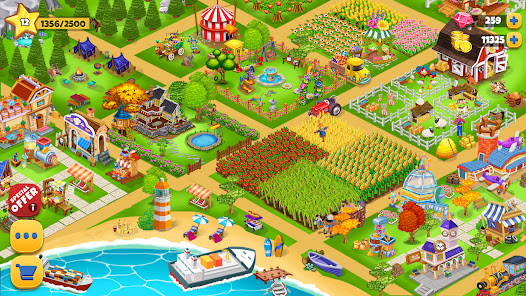The Farm Introduction:
The Farming Game, a board game that replicates the economic challenges of a small farm, was introduced in 1979 by George Rohrbacher, a rancher from Washington state. This game intricately portrays the hardships of farm management, drawing inspiration from real-life experiences. The game's characters and locations are based on families deeply rooted in agricultural traditions in the Yakima Valley and other parts of Central Washington.
The genesis of The Farming Game took place during a critical period for Rohrbacher's own struggling farm and his small family. This adversity is mirrored in the game's complexity, as it encompasses various factors crucial to farming, many of which are often left to chance. The game's impact extended to educational settings worldwide, finding utility as a teaching tool in schools.
Gameplay:
The backdrop for the game emerges from Rohrbacher's own dire circumstances in July 1979. His farm, sprawling across 1,500 acres near Goldendale, was on the brink of bankruptcy, compounded by his wife's pregnancy and her decision to leave her job. A friend's suggestion led Rohrbacher to conceptualize a game akin to Monopoly, centered around the trials of farming life near the Yakima River, their place of residence. The spark of this idea ignited during an early morning hay-baling session. With a $90,000 loan, the first edition of the game was produced with the help of the handicapped individuals at Portland's Goodwill Industries.
Within four months, the inaugural copy was ready, and in just six weeks, nearly 8,000 copies were sold. By 1985, over 150,000 copies had been purchased, rescuing Rohrbacher's farm from financial collapse. By 1995, sales were estimated at 350,000 copies. The game's influence stretched even to the international stage, with the World Bank facilitating a Russian translation in 1994 to educate Russian farmers about capitalist farming principles.
The game's variations include a card game version and a child-friendly edition. Additionally, Rohrbacher's involvement extended beyond game creation, as he served in the Washington State Senate and as a Commissioner for the Columbia River Gorge National Scenic Area.
The game's premise revolves around players inheriting twenty acres of farmland from their "Grandpa," insufficient to sustain them. Players must maintain their town job, yielding $5,000 per game year for farm investment. They can also secure bank loans of up to $50,000, lease pastures, and acquire new land. Victory is achieved by being the first player to expand their farm's net assets to $250,000, enabling them to quit their town job without facing bankruptcy.
Final Words:
The game integrates elements mirroring real-world farming realities. Instances include "Farmer's Fate" cards, akin to Monopoly's "Chance" cards, which bring either favorable or unfavorable outcomes. These cards capture the element of chance inherent in farming.
The game board represents the weeks of a year, divided into squares reflecting different harvest seasons. Winter is the only time for purchasing, while harvest outcomes might vary in yield or value. Players roll dice, progress across the board, and harvest crops as opportunities arise. Crops are acquired through "Option to Buy" cards, categorized as hay, fruit, grain, or cattle. Operating expenses, true to real-life farming challenges, offset gains. Upon harvesting, players draw "Operating Expense" cards, which may entail costs like irrigation or seed bills. "Farmer's Fate" cards also play a role, often resulting in unfortunate events for players, echoing events such as the 1970s drought or natural disasters. Additionally, the board itself introduces expenses or bonuses while navigating—some spaces necessitate fees for circumstances like winter-killed wheat or livestock ownership, while others offer bonuses for timely weather occurrences.

.jpg)

.jpg)

No comments:
Post a Comment